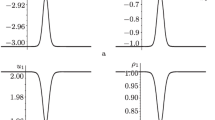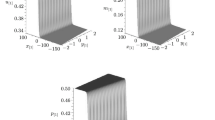Abstract
A dressing method is applied to a matrix Lax pair for the Camassa–Holm equation, thereby allowing for the construction of several global solutions of the system. In particular, solutions of system of soliton and cuspon type are constructed explicitly. The interactions between soliton and cuspon solutions of the system are investigated. The geometric aspects of the Camassa–Holm equation are re-examined in terms of quantities which can be explicitly constructed via the inverse scattering method.










Similar content being viewed by others
Notes
This should not be confused with J from the ZS spectral problem (2.11).
References
Camassa, R., Holm, D.: An integrable shallow water equation with peaked solitons. Phys. Rev. Lett. 71, 1661–1664 (1993). arXiv:patt-sol/9305002
Camassa, R., Holm, D., Hyman, J.: A new integrable shallow water equation. Adv. Appl. Mech. 31, 1–33 (1994)
Chen, S., Foias, C., Holm, D.D., Olson, E., Titi, E.S., Wynne, S.: A connection between the Camassa–Holm equations and turbulent flows in channels and pipes. Phys. Fluids 11, 2343–2353 (1999). https://doi.org/10.1063/1.870096
Constantin, A.: On the inverse spectral problem for the Camassa–Holm equation. J. Funct. Anal. 155, 352–363 (1998)
Constantin, A.: Existence of permanent and breaking waves for a shallow water equation: a geometric approach. Ann. Inst. Fourier (Grenoble) 50, 321–362 (2000)
Constantin, A.: On the scattering problem for the Camassa–Holm equation. Proc. R. Soc. Lond. A 457, 953–970 (2001)
Constantin, A., Escher, J.: Global existence and blow up for a shallow water equation. Ann. Sc. Norm. Sup. Pisa Ser. IV 26, 303–328 (1998a)
Constantin, A., Escher, J.: Wave breaking for nonlinear nonlocal shallow water equations. Acta Mathematica 181, 229–243 (1998b)
Constantin, A., McKean, H.P.: A shallow water equation on the circle. Commun. Pure Appl. Math. 52, 949–982 (1999)
Constantin, A., Strauss, W.: Stability of peakons. Commun. Pure Appl. Math. 53, 603–610 (2000)
Constantin, A., Kolev, B.: Geodesic flow on the diffeomorphism group of the circle. Comment. Math. Helv. 78, 787–804 (2003)
Constantin, A., Lannes, D.: The hydrodynamical relevance of the Camassa–Holm and Degasperis–Procesi equations. Arch. Ration. Mech. Anal. 192, 165–186 (2009)
Constantin, A., Ivanov, R.: Dressing method for the Degasperis–Procesi equation. Stud. Appl. Math. (2016). https://doi.org/10.1111/sapm.12149. arXiv:1608.02120 [nlin.SI]
Constantin, A., Gerdjikov, V., Ivanov, R.: Inverse scattering transform for the Camassa–Holm equation. Inv. Probl. 22, 2197–2207 (2006). arXiv: nlin/0603019v2 [nlin.SI]
Constantin, A., Gerdjikov, V., Ivanov, R.: Generalised Fourier transform for the Camassa–Holm hierarchy. Inv. Probl. 23, 1565–1597 (2007). arxiv:nlin.SI/0707.2048
Constantin, A., Ivanov, R., Lenells, J.: Inverse scattering transform for the Degasperis–Procesi equation. Nonlinearity 23, 2559–2575 (2010). arXiv:1205.4754 [nlin.SI]
Dai, H.-H.: Model equations for nonlinear dispersive waves in a compressible Mooney–Rivlin rod. Acta Mech. 127, 193–207 (1998)
de Monvel, A.B., Shepelsky, D.: Riemann–Hilbert approach for the Camassa–Holm equation on the line. C. R. Math. Acad. Sci. Paris 343, 627–32 (2006)
de Monvel, A.B., Shepelsky, D.: A Riemann–Hilbert approach for the Degasperis–Procesi equation. Nonlinearity 26, 2081–2107 (2013). arXiv:1107.5995 [nlin.SI]
Degasperis, A., Procesi, M.: Asymptotic integrability. In: Degasperis, A., Gaeta, G. (eds.) Symmetry and Perturbation Theory, pp. 23–37. World Scientific, Singapore (1999)
Degasperis, A., Holm, D., Hone, A.: A new integrable equation with peakon solutions. Theor. Math. Phys. 133, 1461–1472 (2002)
Dullin, H.R., Gottwald, G.A., Holm, D.D.: Camassa–Holm, Korteweg–de Vries-5 and other asymptotically equivalent equations for shallow water waves. Fluid Dyn. Res. 33, 73–95 (2003)
Dullin, H.R., Gottwald, G.A., Holm, D.D.: On asymptotically equivalent shallow water wave equations. Physica D 190, 1–14 (2004)
Fokas, A.S.: On a class of physically important integrable equations. Physica D 87, 145–150 (1995)
Fokas, A.S., Fuchssteiner, B.: On the structure of symplectic operators and hereditary symmetries. Lett. Nuovo Cimento 28, 299–303 (1980)
Gerdjikov, V., Vilasi, G., Yanovski, A.: Integrable Hamiltonian Hierarchies. Spectral and Geometric Methods. Lecture Notes in Physics, vol. 748. Springer, Berlin (2008)
Gesztesy, F., Holden, H.: Soliton Equations and Their Algebro–Geometric Solutions, Volume I: (1+1)-Dimensional Continuous Models. Cambridge Studies in Advanced Mathematics, vol. 79. Cambridge University Press, Cambridge (2003)
Holm, D., Staley, M.: Nonlinear balance and exchange of stability in dynamics of solitons, peakons, ramps/cliffs and leftons in a \(+1\) nonlinear evolutionary PDE. Phys. Lett. A 308, 437–444 (2003)
Holm, D., Marsden, J.: Momentum maps and measure-valued solutions (peakons, filaments and sheets) for the EPDiff equation. In: Marsden, J., Ratiu, T. (eds.) The Breadth of Symplectic and Poisson Geometry. Progr. Math., vol. 232, pp. 203–235. Birkhäuser, Boston (2004)
Holm, D., Ivanov, R.: Smooth and peaked solitons of the Camassa–Holm equation and applications. J. Geom. Symm. Phys. 22, 13–49 (2011)
Holm, D., Marsden, J., Ratiu, T.: The Euler–Poincaré equations and semidirect products with applications to continuum theories. Adv. Math. 137, 1–81 (1998a)
Holm, D., Marsden, J., Ratiu, T.: Euler–Poincaré models of ideal fluids with nonlinear dispersion. Phys. Rev. Lett. 349, 4173–4176 (1998b)
Hone, A.: The associated Camassa–Holm equation and the KdV equation. J. Phys. A Math. Gen. 32, L307–L314 (1999)
Ivanov, R.I.: Conformal properties and Bäcklund transform for the associated Camassa–Holm equation. Phys. Lett. A 345, 235–243 (2005). arxiv:nlin.SI/0507005
Ivanov, R., Lyons, T., Orr, N.: A dressing method for soliton solutions of the Camassa–Holm equation. AIP Conf. Proc. 1895, 040003 (2017). https://doi.org/10.1063/1.5007370
Johnson, R.S.: Camassa–Holm, Korteweg–de Vries and related models for water waves. J. Fluid. Mech. 457, 63–82 (2002)
Johnson, R.S.: On solutions of the Camassa–Holm equation. Proc. R. Soc. Lond. A 459, 1687–1708 (2003a)
Johnson, R.S.: The Camassa–Holm equation for water waves moving over a shear flow. Fluid Dyn. Res. 33, 97–111 (2003b)
Kirillov, A.: The orbits of the group of diffeomorphisms of the circle, and local Lie superalgebras. Funct. Anal. Appl. 15, 135–136 (1981)
Kirillov, A.: The orbit method, II: infinite-dimensional Lie groups and Lie algebras. Contemp. Math. 145, 33–63 (1993)
Li, Y., Zhang, J.: The multiple-soliton solutions of the Camassa–Holm equation. Proc. R. Soc. Lond. A 460, 2617–2627 (2004)
Matsuno, Y.: Parametric representation for the multisoliton solution of the Camassa–Holm equation. J. Phys. Soc. Jpn. 74, 1983–1987 (2005). arXiv:nlin.SI/0504055
Matsuno, Y.: The peakon limit of the N-soliton solution of the Camassa–Holm equation. J. Phys. Soc. Jpn. 76, 034003 (2007). arXiv:nlin/0701051
Misiolek, G.: A shallow water equation as a geodesic flow on the Bott–Virasoro group. J. Geom. Phys. 24, 203–208 (1998)
Novikov, S.P., Manakov, S.V., Pitaevsky, L.P., Zakharov, V.E.: Theory of Solitons: The Inverse Scattering Method. Plenum, New York (1984)
Parker, A.: On the Camassa–Holm equation and a direct method of solution I. Bilinear form and solitary waves. Proc. R. Soc. Lond. A 460, 2929–2957 (2004)
Parker, A.: On the Camassa–Holm equation and a direct method of solution II. Soliton solutions. Proc. R. Soc. Lond. A 461, 3611–3632 (2005a)
Parker, A.: On the Camassa–Holm equation and a direct method of solution III. N-soliton solutions. Proc. R. Soc. Lond. A 461, 3893–3911 (2005b)
Parker, A.: Cusped solitons of the Camassa–Holm equation I. Cuspon solitary wave and antipeakon limit. Chaos Solitons Fractals 34, 730–739 (2007)
Parker, A.: Cusped solitons of the Camassa–Holm equation. II. Binary cuspon–soliton interactions. Chaos Solitons Fractals 41, 1531–1549 (2009)
Parker, A., Matsuno, Y.: The peakon limits of soliton solutions of the Camassa–Holm equation. J. Phys. Soc. Jpn. 75, 124001 (2006)
Popivanov, P., Slavova, A.: Nonlinear Waves: An Introduction. World Scientific, Hackensack (2011)
Rasin, A., Schiff, J.: Bäcklund transformations for the Camassa–Holm equation. J. Nonlinear Sci. 27, 45–69 (2017). https://doi.org/10.1007/s00332-016-9325-6. arXiv:1508.05636 [nlin.SI]
Zakharov, V.E., Shabat, A.B.: A scheme for integrating nonlinear evolution equations of mathematical physics by the inverse scattering method. I. Funct. Anal. Appl. 8, 226–235 (1974)
Zakharov, V.E., Shabat, A.B.: Integration of the nonlinear equations of mathematical physics by the inverse scattering method II. Funct. Anal. Appl. 13, 166–174 (1979)
Acknowledgements
R.I. is grateful to Prof. D.D. Holm for many discussions on the problems treated in this paper.
Author information
Authors and Affiliations
Corresponding author
Additional information
Communicated by Anthony Bloch.
Publisher's Note
Springer Nature remains neutral with regard to jurisdictional claims in published maps and institutional affiliations.
Appendix
Appendix
In appendix, we provide some details on the derivation of the soliton–cuspon solution. Applying equation (3.2) to the dressing factor g as given by Eq. (4.54) ensures the matrix-valued residues satisfy the following
Writing the rank one matrix solutions \(A_1\) and \(B_2\) in the form
we deduce
The vectors \(\left\langle {m}\right| ,\left\langle {M}\right| \) satisfy the bare equations and therefore are known in principle and have been obtained previously (see Sects. 4.3–4.4).
The dressing factor (4.54) at \(\lambda =0\) is
while the differential equation for X(y, t) is
Choosing \(m_1, m_2\) as per the soliton solution cf. (Ivanov et al. 2017) and recalling \(\Lambda _1=\sqrt{h_0^2-\omega _1^2}\), we then have
where \(\mu _k\) are positive constants. Ignoring an irrelevant overall constant of \(\sqrt{\mu _1 \mu _2}(2\Lambda _1)^{-1/2}\) (see Sect. 4.3) and changing the definition of \(\Omega _1(y,t)\) by an additive constant, as given by
we obtain the simplified expressions
Similarly, as per the cuspon solution, we define the constant vector \(\left\langle {M_{(0)}}\right| V_2= (\nu _1, \nu _2)\) with \(\nu _1, \nu _2\) real and positive, thereby ensuring
The expression
whose explicit form may be deduced from Eqs. (7.7)–(7.8), has denominator
where we note that \(\Lambda _2> h_0 > \Lambda _1\), thus ensuring \(\Lambda _2 - \Lambda _1 >0\).
Introducing the constants
we rewrite this denominator according to
Similarly, it is found that the numerator assumes the form
As with the two-cuspon solutions, we seek a solution of Eq. (4.32) in the form of Eq. (4.13) with
where the constants \(\left\{ \alpha _l\right\} _{l=1}^{4}\) are as yet unknown. Equation (4.32) ensures that
has a solution given by
The ratio \(\mathcal {A}_{CS}/\mathcal {B}_{CS}\) may now be written as
which we simplify by means of the following re-definitions:
These re-definitions are valid since \(\Lambda _2> \Lambda _1\), as was previously noted. Alternatively, these may be simply written as
for some constants \(\left\{ \xi _k\right\} _{k=1}^{2}\) related to the initial separation of the cuspon and soliton. This allows the expression (7.17) to be written as
with
Rights and permissions
About this article
Cite this article
Ivanov, R., Lyons, T. & Orr, N. Camassa–Holm Cuspons, Solitons and Their Interactions via the Dressing Method. J Nonlinear Sci 30, 225–260 (2020). https://doi.org/10.1007/s00332-019-09572-1
Received:
Accepted:
Published:
Issue Date:
DOI: https://doi.org/10.1007/s00332-019-09572-1




